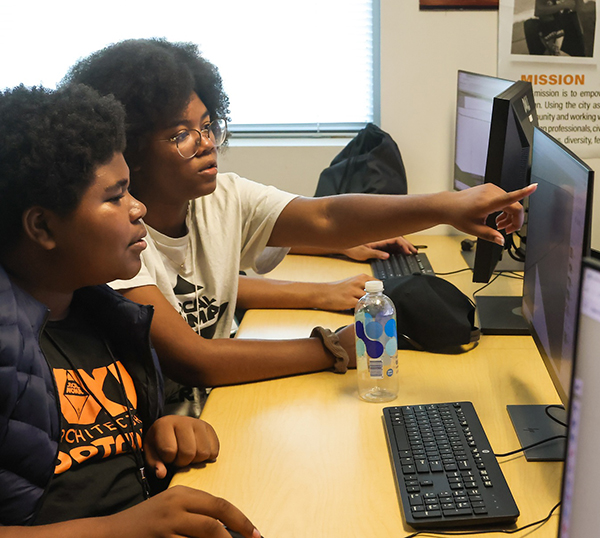By Shirley Hawkins
Contributing Writer
LOS ANGELES — A summer camp for minority students interested in pursuing a career in architecture will take place over two weekends at East Los Angeles College later this month.
The camp, sponsored by the Southern California Chapter of the National Organization of Minority Architects (NOMA), will be held July 14-15 and July 21-22 from 9 a.m. to 5 p.m. Students between 10 and 18 may enroll in the camp, which has a $100 registration fee. The deadline to apply is July 11. Interested youth can access www.SocalNOMA.org for more information.
According to statistics from the National Organization of Minority Architects, only 2% of African Americans are currently working in the architecture field.
To increase the number of underrepresented minorities in the architectural field, SoCal Noma, a national initiative of NOMA, holds an intensive design process that is broken down into eight in-depth sessions. The Project Pipeline program is facilitated by leading African American architects and planners to introduce minority youth to the profession.
Now in its 14th year, the architecture camp is operated by Project Pipeline. The program is designed to provide students with a platform to discuss, analyze and interpret the impact of design, art and architecture through a focused curriculum with creative outcomes.
Participants are guided through all stages of design through drawing and model building and are able to analyze through diagramming and research, and engage other professionals through interviews and site visits.
They learn to design with computers, Computer Aided Drafting and draw their building ideas on paper in sketch-up class. By the program’s conclusion, students present a fully essential project that addresses an issue in their city.
Questioned as to why there are so few African American architects, SoCal NOMA director Eletrice Harris said, “The main issue is that minority youth are not introduced to the idea of architecture until college, but we try to expose them to the profession when they are much younger to spark their interest in pursuing an architecture career.”
Harris, who is a professor of architecture at Woodbury University, added, “The path to becoming an architect is that young people need to finish the proper math and science classes while still in high school and then be introduced to the profession.”
She said that aspiring minority architects also need to be taught by teachers who they can relate to.
“It’s easier when you see someone who is working in the architecture field that looks like you,” Harris said. “They need to see someone who looks like them because they cannot be what they cannot see.”
Harris, who mentors 20 students, said students can receive tutoring from volunteers adding that financial aid is available to help students pay the fee required for architecture licensing exam after they complete their degree.
“We pay for exams and purchase the study materials for them,” she added.
The testing to enter the architecture profession can be rigorous, Harris said.
“Aspiring architects have to practice taking the national architect exam given by the state to become licensed as an architect,” she said. “The students have five years to finish five to six exams and we teach them how to navigate the exam and testing experience.”
Inglewood resident Caleb Brown is a veteran of the Project Pipeline program who now serves as a mentor to other Pipeline youth. “I’m an eight-year summer camper,” he said.
Brown said his interest in architecture started early.
“I was always interested in putting things together and taking things apart,” said Brown, who currently attends Howard University. “My parents noticed my interest at an early age and they picked my interest up. My father brought me to the NOMA camp.
“Through NOMA, I was able to prepare myself for an architectural career from high school through college,” Brown added. “I was able to go onsite and see my community being changed, like the building of SoFi stadium and the K Line through architecture.
“Architecture has always been a guilty pleasure for me,” he said. “Building boats and rocket ships in the future is the niche I look forward to pursuing.”
Although still undecided about what segment of architecture he will pursue, Brown is considering becoming an architect for the Navy.
Akira Macklin, a graduate of the SoCa; NOMA program, is in her third year at Cal Poly Pomona.
“I went to the NOMA camp in 2019,” Macklin said. “I knew I wanted to be an architect and my mom found the NOMA organization. The camp did a really good job of introducing me to architecture and I loved seeing people who looked like me.
“I enjoyed learning the three softwares — Sketch Up, Revit and Autocad — while there and I got to shadow an architect for three days.”
Macklin is now an intern at the camp helping aspiring architects to reach their goals.
As for the future, Mackin said, “I have always been interested in designing a museum or telling a history. I am interested in the historical side of architecture.”
SoCal NOMA has been a lifeline to me,” Harris said. “NOMA is a family where I can go to and be surrounded by top professionals who are willing to assist, help and support.”
Shirley Hawkins is a freelance reporter for Wave Newspapers. She can be reached at metropressnews@gmail.com.










